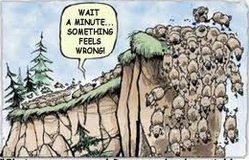 In-Gold-we-Trust-2014-Incrementum
In-Gold-we-Trust-2014-Incrementum
The above 100-page report on gold will provide a good financial history lesson.
A Reader’s Question
I was thinking about how many people think that the sell-side is just wrong about everything and completely untrustworthy. From what I can tell, they are pretty good with the facts and a really valuable source when you want to learn about a new industry via a primers or initiation reports. This led me to think that most of the sell-side critics think that they have an analytical edge over the sell-siders. Maybe even an informational edge (which I think is very unlikely since these analysts cover one industry full-time.) But certainly an edge in judgment or behavior. This I think is possible if you have a longer-time horizon and no man-with-a-hammer syndrome.
What sort of edge do you think is most achievable over the markets in general for an investor that is dedicated? I’m thinking about full-time investors.It seems to me that analytic edges are often overstated. What are some cases that the sell-side or entire markets are just completely off on their analysis? Maybe the optimistic analysts during the bubble years? Is this just misaligned incentives?
I would guess that the market usually mis-weighs the probabilities of what may happen in the future, but that would be more of a misjudgment in my opinion. (Maybe this is just semantics.)
I’d love to hear your thoughts.
My reply: I agree that analysts can provide great overviews of companies and industries in their initiation reports. I will read them as a supplement to my own reading of original source documents. I would not read them for valuation or investment recommendations. The idea that analysts can predict next quarter’s earnings is absurd. Finding a reasonable range of normalized earnings three years to five years out is what matters, not the next six months of earnings.
Another reason I might try to read analysts reports is not for new ideas, but to see the extent to which the market is already discounting my own views. Note the universal calls from analysts at Goldman and UBS for gold to trade to $900 or $800 See www.acting-man.com:
“Goldman Sachs lowers gold price target to $1,050” (Bloomberg, Reuters, etc. sometime in January and repeated ad nauseam ever since)
“Moody’s lowers gold price target to $900” (January)
“Morgan Stanley: Gold price won’t see $1,300 again” (April)
Also, analysts may overlook key values in a company because they fixate on the next six months. For example, the most common way of valuing an exploration and production company is an appraisal of net asset value, based on sum-of-the parts approach. But most appraisals tend to ignore exploration assets which are not going to be drilled within some arbitrary time period, say the next 6 to 12 months. For some companies, much of the value is in assets which are not going to be drilled in the next year.
I think most of an investor’s edge is behavioral. (See http://www.amazon.com/Inefficient-Markets-Introduction-Behavioral-Clarendon/)
Take Coach’s (COH) recent plunge.
Coh Comments June 2014 and June 23 VL 2014 The company has to increase its investment to rebuild its brand. Wall Street analysts then act like this:
Therein lies opportunity or maybe not. But if the markets didn’t act that way, then markets would not overreact. Markets tend to over-discount a known risk or uncertainty and under-discount an unknown uncertainty.




